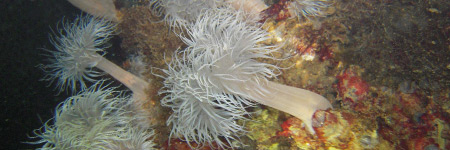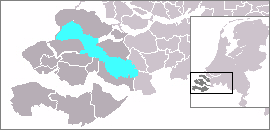“Diving in the Netherlands?! That’s extremely cold, you won’t see a thing and there is no life to be found anywhere!” This is a possible reaction from someone that has never dived in The Netherlands. However, this cannot be further from the truth! Diving in our country is great!
In order to handle the cold waters, you simply wear a wetsuit with a thickness of at least 7mm. In summertime or when wearing a new wetsuit, diving can actually be very warm! About the visibility: the Netherlands are not surrounded by tropical waters where you can see further than 20 meters underwater. The visibility in the Netherlands is usually between 3 and 10 meters; less during bad weather but when you are lucky it can be even more than 10 meters. And believe us, this lower visibility is not an issue, it makes the dive only more exciting.
True, the underwater life in the Netherlands may not be as colourful as it is in tropical places but you will still find beautiful creatures, and lots of them! We invite you to dive with us and discover the Dutch underwater world.
TynaarloPermalink
Veenmeer lake (part of camping ’t Veenmeer) is a well-known dive spot in the Northern Netherlands, located near Tynaarlo in Drenthe. As this lake is only 10 minutes away from Groningen by car, it is one of our most frequented dive spots for training. The lake stretches about 100 x 300 meters, reaching up to 18 meters in depth. All requirements for an effective and interesting dive training are present here: you can get in and out of the water easily, the ground is mostly sandy, there are platforms at several depths to do your exercises, and there is a buoy with a large chain that indicates the lake’s deepest point. The visibility varies generally between 1,5 to 5 meters.
You can find a variety of creatures in Veenmeer lake: various species of freshwater plants, schools of minnow (Dutch: voorntjes) and perch (baarzen) are a frequent sighting, with carp (karpers) and tench (zeelten) also cruising around. Pikes (snoeken) in this lake are very accustomed to divers and will often curiously check you out. They are also known for posing nicely in front of the camera. Crayfish (rivierkreeft) and freshwater crabs (zoetwaterkrabben) walk around in the sunken longboat or along the lobster wall (“Kreeftenmuur”), looking for aquatic plants or anything else they can find to eat. If you look carefully, you can spot a large eel (paling) slithering across the lake floor. Perhaps the most well-known and also the most elusive resident of Veenmeer lake is one you wouldn’t expect to find there: the red-eared slider (roodwangschildpad). This exotic animal was released in the lake some time ago but is fortunately doing well. It likes to play hide and seek though, which is why ‘finding the turtle’ is a popular challenge among divers.
You can also find may objects: a helicopter simulator, street signs, little boats, Christmas trees, car tires, a toilet and a huge delta flyer.
This diving spot has something to offer for everyone. You can bathe in the sun, relax on the grass, socialize with other divers (or the guests you bring along). The spot is well suited for night dives. You can also spend the night there if you bring your own tent. This way you can be in the water very early.
ZeelandPermalink
The province of Zeeland hosts the most beautiful diving spots of the Netherlands. We dive in Lake Grevelingen (non-tidal) and the Oosterschelde (tidal waters).
Grevelingenmeer

Lake Grevelingen is the largest saltwater lake of Western Europe. In 1971, the lake was closed off from the North Sea by a dike (the Brouwersdam) in an effort to protect the southwest of the Netherlands from flooding. Since Lake Grevelingen is currently semi-closed off from the North Sea, it doesn’t experience strong tides, allowing you to dive throughout the day.
Lake Grevelingen is very popular among divers for a reason: it has great visibility (for Dutch standards) and a variety of interesting marine life. Especially the large red lobsters are well-known residents of the lake. These lobsters are a protected species and they seem to know it, allowing you to get quite close to them. You can find sea sponges, seasquirts and anemones growing on the both the rocks and sediment and the manmade structures in the lake. Different types of goby and wrasse are swimming around, and you can also spot large crabs and various species of nudibranch (zeenaaktslak). All in all, Lake Grevelingen is an interesting, colourful place definitely worth exploring!

Oosterschelde

The Oosterschelde is a former estuary and contains the largest national park in the Netherlands. The Oosterschelde is saline (has salt water) and experiences tides. The tides in the Oosterschelde makes diving more challenging; it also means that at certain times of the day the visibility can be less than optimal.
Because of the large variety of sea life, including unique regional species, the Oosterschelde attracts divers from all over the world. On top of all species that are found in Lake Grevelingen, the Oosterschelde hosts the fascinating and intelligent cuttlefish (Dutch: sepia’s/zeekatten) and seahorses!
Ad Fundum frequently organizes Zeeland Weekend trips. We usually stay there from Friday to Sunday in caravans on the middle of the island (Schouwen-Duivenland). From here we explore Zeeland. These weekends guarantee coziness, excitement and beautiful diving experiences.
Other dive spotsPermalink
Some other place we visit that are worth mentioning:
Ruinerwold, “the most beautiful lake in the North” is comparable to Tynaarlo but with more underwater life and better visibility. Ruinerwold is about a 50 minutes’ drive away from Groningen.
In Joure (in the Province of Friesland) lies a clear but dark lake: Lake Woudfennen. This lake is almost 20 meters deep everywhere and you can spot huge pike. Joure is a one hour drive away from Groningen.
NaturaGart (Ibbenbüren, Germany) is one of the largest artificial diving pools in the world. You’ll find various rock formations, ruins, caverns and corridors, a shipwreck and sturgeons measuring up to 2 meters! A must-dive for everyone!